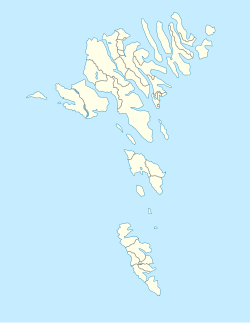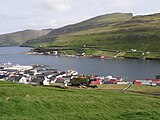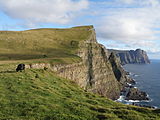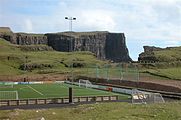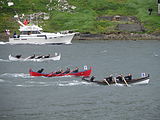
Tvøroyri is a village on the north side of the Trongisvágsfjørður on the east coast of Suðuroy island in the Faroe Islands. Together with Froðba, Trongisvágur, Líðin and Øravík it forms Tvøroyri Municipality.
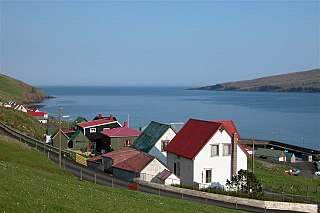
Hov is a village located on Suduroy's east coast, in the Faroe Islands; it is frequently mentioned in the country's history.

Hvalba is a village and a municipality in the Faroe Islands, which consists of Hvalba, Nes-Hvalba and Sandvík.

Porkeri is a village in the Faroe Islands, situated northeast of Vágur on Suðuroy's east coast.

Suðuroy is the southernmost of the Faroe Islands. The island covers 163.7 square kilometres (63.2 sq mi). In 2018 the population was 4,601. Suðuroy region (sýsla) comprises this island and Lítla Dímun, the next isle northward in the Faroes, which is uninhabited.

The Sloop Period Faroese: Slupptíðin is a period in Faroese history, where the Faroese society transformed from a feudal society to a semi-industrial society. The period spans from the 1880s to the beginning of World War II.

Sandvík is the northernmost village of the island of Suðuroy in the Faroe Islands. It is situated on the northern side of a shallow fjord. The village was previously known as Hvalvík. It changed its name to Sandvík in 1913 as there was too much confusion regarding mail delivery, because there is another village named Hvalvík on Streymoy. The village had originally been known as Sandvík during the Viking Age.
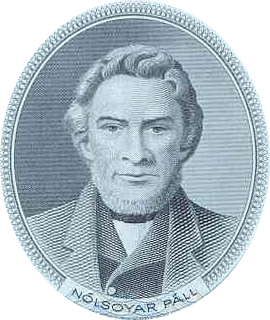
Nólsoyar Páll is a Faroese national hero. He was a seaman, trader, poet, farmer and boat builder who tried to develop direct trade between the Faroes and the rest of Europe and introduced vaccination to the islands. He went missing in the winter of 1808–1809 sailing home from England.

Øravík is a village on the east coast of the island of Suðuroy in the Faroe Islands.

Vágs Bóltfelag (VB) is a Faroese handball club. It started as a football club, which was founded on 5 June 1905, but later the sport handball became a part of the club. The handball club is based in Vágur in Suðuroy. They play their home matches in the sports hall, Vágshøll on Eiðinum in Vágur. The football club is now known as FC Suðuroy.

á Eiðinum is a multi-use stadium in Vágur, which is one of the larger villages in the southernmost island Suduroy in the Faroe Islands. It is currently used mostly for football matches and is the home ground of FC Suðuroy, formerly called VB/Sumba. The stadium holds 3,000 people, but has only 330 seats.

Nes is a village on the Faroese island of Suðuroy located in the municipality of Vágur. It is located west of Porkeri and east of Vágur.

Tvøroyrar Bóltfelag is a Faroese professional football club from Tvøroyri, currently playing in the Betrideildin, the top tier of Faroese football. TB Tvøroyri is the oldest football club in the Faroe Islands, and also one of the oldest in the Danish Realm, in which the Faroe Islands are a self-governing country.

Aggi Ásgerð Ásgeirsdóttir is a Faroese artist. She was born in Tórshavn, Faroe Islands. She was educated in Denmark and then moved back to the Faroe Islands, to the small village of Vágur in Suðuroy, which is the southernmost island. In the summer 2009 Aggi moved to Tórshavn or to Argir, now part of the municipality of Tórshavn. While Aggi was living in Suðuroy, her art was her main occupation, and also mentored Ruth Smith Art Museum in Vágur, she was the chairman of the association "Skálin við Skálá", which owns the museum. Aggi often showed the museum for tourists while she was living in Vágur.

Bjarni Johansen is a Faroese politician and former goal keeper. He is the current mayor of Vágur Municipality, elected for the Social Democratic Party in November 2020 to the Municipality and became mayor from 1 January 2021. He is former chairman for the Faroese football association FC Suðuroy.

FC Suðuroy is a Faroese football club which was founded in January 2010 and consists of the former clubs VB and Sumba, which merged in 2005 to form VB/Sumba. FC Suðuroy's first team in the men's championship competes in the 1. deild in 2024. All teams play their home games at the á Eiðinum Stadium in Vágur. The club logo was designed by the photographer Rógvi Nolsøe Johansen in 2010, the same year he won the competition to design a logo for the club.

Royn Hvalba or Bóltfelagið Royn, or just Royn, is a Faroese football and sports association from Hvalba in Suðuroy, founded on 23 October 1923. The chairman for Royn Hvalba is Poul Laust Christiansen. Manager is Brynjar Poulsen. Royn has a team in the Faroese second division. Royn also has teams for girls and boys, in 2012 they had a team for girls under 12, a team for boys U8 and one for boys U10. Royn and TB Tvøroyri now have a new manager for all the youth teams of the two clubs. Men over 35 have their own team. The women had their own team earlier. Royn is one of three football associations in the island Suðuroy. The other two football clubs are FC Suðuroy with base in Vágur and TB Tvøroyri from Tvøroyri. Royn Hvalba plays its home matches on the football field in Hvalba, which is the only grass field left in the Faroe Islands.

Vágsfjørður is a fjord on the island of Suðuroy in the Faroe Islands. The fjord is located in the southern part and on the eastern side of the island. The distance between the east and the west coast of Suðuroy is very short from Vágsfjørður to Vágseiði. Between the fjord and Vágseiði is a lake which is called Vatnið. There are five villages around the fjord. In the bottom of the fjord is Vágur, which is one of the largest of the villages in Suðuroy. Further east on the northern side of the fjord is Porkeri, in between Vágur and Porkeri is the small village Nes, where a famous artist Ruth Smith lived. She drowned while swimming in Vágsfjørður at the age of 45.

Vágs Kappróðrarfelag is a Faroese rowing club from Vágur in Suðuroy, which was founded in July 1943.
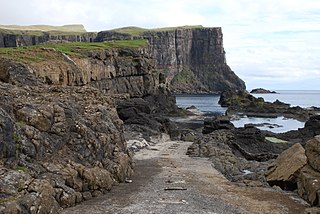
Vágseiði is an area in Vágur, Faroe Islands, located on the west coast of Suðuroy west of the village Vágur, from which it takes its name. Eiði is the Faroese word for isthmus. The distance between the east and the west coast of Vágur is only one km. There is a lake between the village and Vágseiði, the lake is called Vatnið, which is the Faroese word for Lake. The football stadium of FC Suðuroy and the sports hall Vágshøll are located on Vágseiði, 100-200 m from the cliffs. The natural harbour on Vágseiði is called Kleivin. The 200m high cliff south of Vágseiði is called Skúvanes, and the cliffs from Skúvanes towards south are called Eggjarnar. There is a skerry, which looks like some rocks, in the bay of Vágseiði, this skerry is called Heltnarnar. The sea is often rough here and the waves often break against the cliffs here, and often Heltnarnar almost disappear in the surf.



